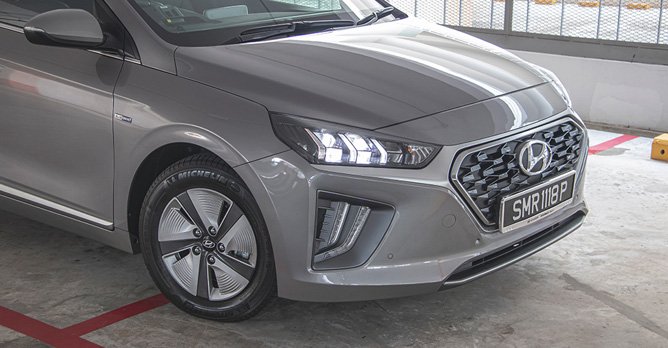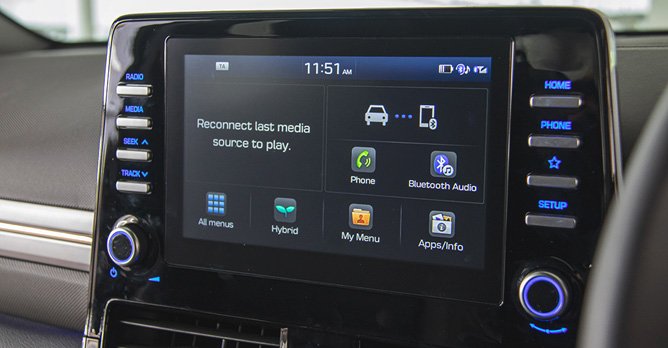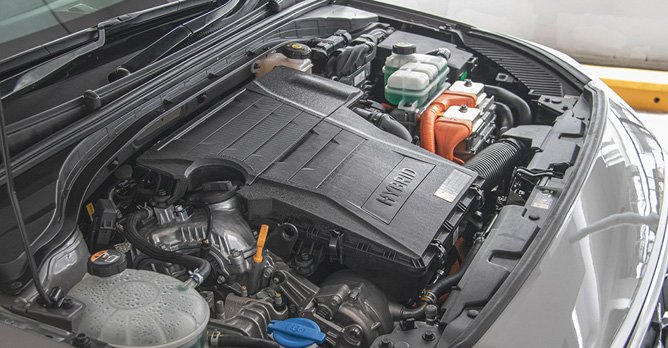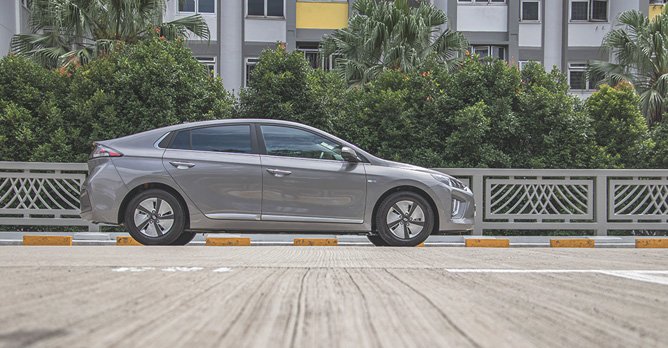Hyundai Ioniq Hybrid 1.6 Sunroof (A) Facelift Review
21 Jan 2020|12,270 views
Facelift (What's New)
8.0-inch touchscreen display with Android Auto and Apple CarPlay
Mesh-type radiator grille with silver-coloured mouldings
Redesigned LED Daytime Running Lights as well as head and taillights
Hyundai's Ioniq nameplate - a portmanteau of ion and unique - may place special emphasis on the car's unique electrified drivetrain, but after two days of driving the car, I actually found it to be quite the homely thing.
And that's a good trait to have as well, since I suspect most shoppers in the segment would be of the practical sort.
A handsome thing
Unlike the fussy and divisive styling of its most obvious rival - the Toyota Prius - the 2020 Ioniq Hybrid tested here has received a few cosmetic tweaks that grace it with a style more consistent with regular cars.
The new mesh-type grille brings the car closer in line with Hyundai's other offerings such as the Santa Fe and the i30, while the silver-coloured moulding on the bottom of said grille remind me of the chrome highlight found on the grille of the equally handsome Mazda3.
A cosy space
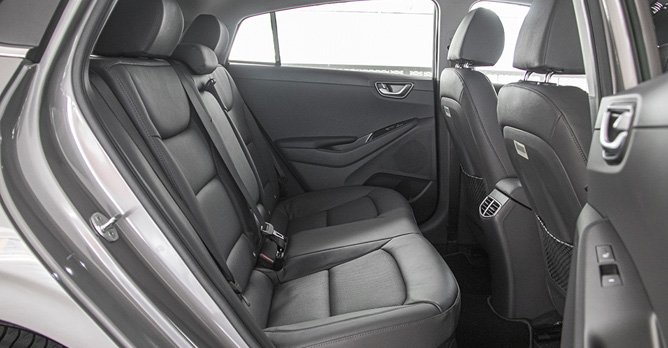
Those of taller builds will want to give the car a good sit-in at the showroom, as I found myself testing the limits of the rear-view mirror's adjustability despite having the driver seat set in its lowest position.
Having said that I actually found the rear seats rather easy to get in and out of despite the sloping roofline. Leg and kneeroom is otherwise generous for all occupants.
Look beyond just space for a second and the car fairs better. The cabin's layout takes little getting used to, with all the buttons located exactly where you would expect them to.
The new 8.0-inch touchscreen infotainment display is equally easy to use and features rotary knobs for the radio tuning and volume adjustment, making quick audio adjustments on the go easy. The new touch-type control buttons for the air-conditioning likewise don't steal your attention from the road, given the fact that they are spaced far apart from each other.
But I think the 7.0-inch LCD instrument cluster is more impressive still, with a little cut-out to allow just a sliver of natural light to illuminate your precious driving information.
Swap over to sport mode, and the green surround turns into a red tachometer, while the steering wheel paddles that otherwise control the regenerative braking revert back to controlling the gears. All information on the display is easily readable and the green surround flashes red when the Forward Collision Avoidance Assist is activated, providing you with an additional warning that you really should have your eyes on the road.
Two hearts beating as one
Hyundai's Kappa 1.6-litre Atkinson cycle engine pairs with a six-speed dual-clutch automatic and a 42bhp electric motor to produce a total system output of 130bhp.
Combine that with 265Nm of net torque from the hybrid system and the Ioniq Hybrid yields brisk acceleration, but what truly stands out about the drivetrain is the smoothness of its operation. Transitions between electric-only and petrol-assisted power are practically unperceivable, with power delivery staying smooth and linear regardless of how sloppy your footwork is.
To drive, the Ioniq is a real pleasure. You quickly become used to adjusting the level of regenerative braking via the paddles to eek out that extra fuel economy, and the car's ride is at that ideal softness that allows you to tackle our local speed hump-ridden roads at good speed. The car is well-damped as well, controlling suspension rebound very well even on challenging road undulations.
At slower speeds, the spongey feel from both foot pedals is something I got accustomed to within a day, but at higher speeds the car's Michelin Energy Saver eco-tyres make such a racket on poor road surfaces that you'd probably want to switch them out at the earliest opportunity.
Speaking of which, the combined efforts of the Lane Keep Assist and the BlindSpot Detection systems can make the car rather chatty when driving on busy roads, but they work brilliantly to keep you safe and not once did they fail me during my two days with the car.
Those two days of driving also yielded a fuel economy of 20km/L.
Good enough to take home
At $117,999 (as of 15 January 2020), the Ioniq Hybrid is easy on the eyes, earth, and the wallet. If those sound like all the great things you are looking for in your motoring partner, there's no reason not to bring one home.
Facelift (What's New)
8.0-inch touchscreen display with Android Auto and Apple CarPlay
Mesh-type radiator grille with silver-coloured mouldings
Redesigned LED Daytime Running Lights as well as head and taillights
Hyundai's Ioniq nameplate - a portmanteau of ion and unique - may place special emphasis on the car's unique electrified drivetrain, but after two days of driving the car, I actually found it to be quite the homely thing.
And that's a good trait to have as well, since I suspect most shoppers in the segment would be of the practical sort.
A handsome thing
Unlike the fussy and divisive styling of its most obvious rival - the Toyota Prius - the 2020 Ioniq Hybrid tested here has received a few cosmetic tweaks that grace it with a style more consistent with regular cars.
The new mesh-type grille brings the car closer in line with Hyundai's other offerings such as the Santa Fe and the i30, while the silver-coloured moulding on the bottom of said grille remind me of the chrome highlight found on the grille of the equally handsome Mazda3.
A cosy space

Those of taller builds will want to give the car a good sit-in at the showroom, as I found myself testing the limits of the rear-view mirror's adjustability despite having the driver seat set in its lowest position.
Having said that I actually found the rear seats rather easy to get in and out of despite the sloping roofline. Leg and kneeroom is otherwise generous for all occupants.
Look beyond just space for a second and the car fairs better. The cabin's layout takes little getting used to, with all the buttons located exactly where you would expect them to.
The new 8.0-inch touchscreen infotainment display is equally easy to use and features rotary knobs for the radio tuning and volume adjustment, making quick audio adjustments on the go easy. The new touch-type control buttons for the air-conditioning likewise don't steal your attention from the road, given the fact that they are spaced far apart from each other.
But I think the 7.0-inch LCD instrument cluster is more impressive still, with a little cut-out to allow just a sliver of natural light to illuminate your precious driving information.
Swap over to sport mode, and the green surround turns into a red tachometer, while the steering wheel paddles that otherwise control the regenerative braking revert back to controlling the gears. All information on the display is easily readable and the green surround flashes red when the Forward Collision Avoidance Assist is activated, providing you with an additional warning that you really should have your eyes on the road.
Two hearts beating as one
Hyundai's Kappa 1.6-litre Atkinson cycle engine pairs with a six-speed dual-clutch automatic and a 42bhp electric motor to produce a total system output of 130bhp.
Combine that with 265Nm of net torque from the hybrid system and the Ioniq Hybrid yields brisk acceleration, but what truly stands out about the drivetrain is the smoothness of its operation. Transitions between electric-only and petrol-assisted power are practically unperceivable, with power delivery staying smooth and linear regardless of how sloppy your footwork is.
To drive, the Ioniq is a real pleasure. You quickly become used to adjusting the level of regenerative braking via the paddles to eek out that extra fuel economy, and the car's ride is at that ideal softness that allows you to tackle our local speed hump-ridden roads at good speed. The car is well-damped as well, controlling suspension rebound very well even on challenging road undulations.
At slower speeds, the spongey feel from both foot pedals is something I got accustomed to within a day, but at higher speeds the car's Michelin Energy Saver eco-tyres make such a racket on poor road surfaces that you'd probably want to switch them out at the earliest opportunity.
Speaking of which, the combined efforts of the Lane Keep Assist and the BlindSpot Detection systems can make the car rather chatty when driving on busy roads, but they work brilliantly to keep you safe and not once did they fail me during my two days with the car.
Those two days of driving also yielded a fuel economy of 20km/L.
Good enough to take home
At $117,999 (as of 15 January 2020), the Ioniq Hybrid is easy on the eyes, earth, and the wallet. If those sound like all the great things you are looking for in your motoring partner, there's no reason not to bring one home.
Also read our comparison article on:
Hyundai Ioniq Hybrid 1.6 GLS vs Toyota Prius Hybrid 1.8Car Information
Hyundai Ioniq Hybrid 1.6 DCT Sunroof (A)
CAT A|Petrol-Electric|26.3km/L
Horsepower
97kW (130 bhp)
Torque
265 Nm
Acceleration
11.1sec (0-100km /hr)
This model is no longer being sold by local distributor
All Used Hyundai Ioniq HybridThank You For Your Subscription.
























